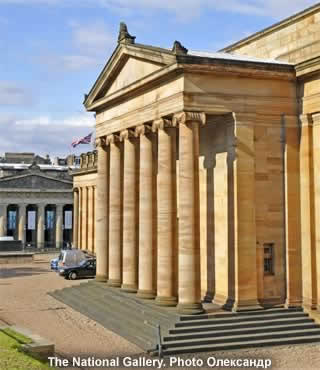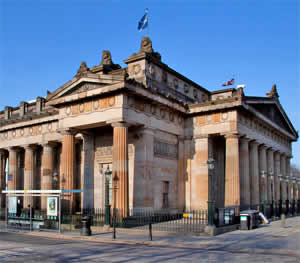National Galleries |
|
 |
|||
Scotland's biggest and best art galleries |
||||
Listen to this article |
||||
|
||||
There used to be a lake in the centre of Edinburgh. It was probably a pretty place once upon a time, but that couldn't last. As the city got bigger, the water got dirtier. People filled it with rubbish and sewage. Suspected witches were dunked beneath its surface, usually with fatal consequences. Ironically, this ugly location eventually became Scotland's biggest shrine to visual beauty. |
||||
The transformation began in the 18th century, when people decided to get rid of the lake altogether. It was drained, and filled in with 1.5 million cartloads of earth. This new stretch of land was dubbed "The Mound", and it quickly became a prime piece of real estate. It was smack bang in the middle of Edinburgh's two busiest streets, within a stone's throw of the castle. Over the years the place played its part in dozens of wars and conflicts, but it was soon to become a battleground of a very different kind. This was the scene of a fierce rivalry in the world of Scottish art. |
||||
The quarrelling parties were the Royal Institution and the Royal Scottish Academy. The latter accused the former of elitism and bad management. At first, they shared a single building, but this arrangement clearly wasn't working. Halfway through the 19th century, both organisations constructed their own galleries. The Royal Institution went first, with a Grecian-style structure on top of the mound. The architect was William Playfair, who was widely hailed as the best in the country. A few years later the Scottish Academy followed suit by helping to establish the National Gallery. This building was also in a Grecian style, also on the mound and also designed by William Playfair. |
||||
It was a strange situation. Edinburgh had two very similar looking art galleries right next door to each other, but not really getting on together! The rivalry ended in the 1900s, when the Royal Scottish Academy took over the Institution's building. However, even then, they continued to be run separately. |
||||
Here in the 21st century, the National Gallery and the Royal Academy still have their own exhibitions and their own displays. However, things are a lot more harmonious. In 2004, the two were finally joined together via an underground walkway. The new space, called the Weston Link, was part of a £35 million project. As well as its restaurant, shop and lecture theatre, it houses a series of computers that display the collections of both galleries. These images remind us that, despite all the complicated history, it's the art that's the most important thing. The two institutions have amassed a huge amount of valuable and important work. |
||||
The exhibitions at the Royal Scottish Academy are relatively modern. They show the development of the nation's artists over the last couple of centuries. This includes the best contemporary pieces from present-day Scotland. |
||||
 Royal Scottish Academy Photo ahisgett |
||||
Next door, the National Gallery's collection includes famous work by international artists like Rembrandt, Monet and Van Gogh. However, the majority of the exhibits focus on local talent. This is the largest collection of Scottish paintings in the world, with literally thousands of examples. It provides a permanent record of the country's visual imagination. |
||||
|
||||
The National Galleries Complex is open daily from 10am to 5pm (7pm Thursdays). Entry is FREE. The Mound, Edinburgh EH2 2EL. Tel: 0131 624 6200 |
||||
|
Pocket Britain is optimised for use on a smartphone or tablet with internet access. All content is subject to copyright. All reasonable methods have been used to ensure information supplied is accurate at the time of publication. However, it is advisable to check information before relying on it. Privacy Policy |